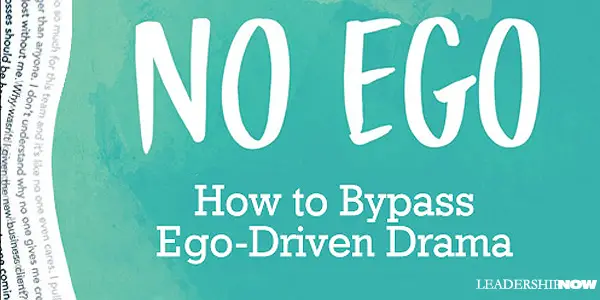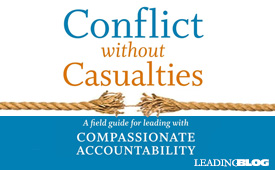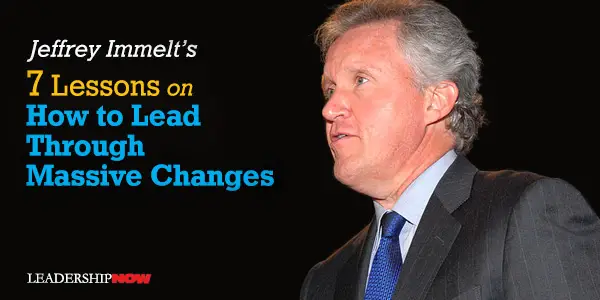 Leading Blog | Posts by Month |
 Leading Blog | Posts by Month |
09.30.17

LeadershipNow 140: September 2017 Compilation
See more on
Posted by Michael McKinney at 08:05 AM
09.22.17

5 Leadership Literacies You Will Need in the Future
F Looking Backward from the Future The present is too noisy to give us much in the way of insight. While most forecasters try to find a trend in the present noise, Johansen says we need to look ten years into the future and then looking backward from the future. “Looking long is using foresight to provoke insight and action.” Looking back from the future provides more clarity than the other way around. “The best way to lead in a disruptive world is to be very clear where you’re going, tell a great story about it, and then be very flexible about how you bring that future to life.” Although Johansen claims that anyone can do this, there isn’t much to explain just how that is done. The suggestion is to see through the noise now to a future that others cannot see to get clarity and dilemma flipping which is to turn unsolvable problems into opportunities. Nevertheless, he does offer some good general advice. The future rewards clarity, but punishes certainty. Having clarity and being certain are two different things. Clarity is simple. Certainty is simplistic. “Clarity is usually expressed in stories, while certainty is usually expressed in rules. Rigid rules can get leaders into a lot of trouble in the VUCA world, while stories encourage people to engage.” We can get stuck in the present and the issues of the day. “Sometimes, focusing on the future can help people move beyond the polarities of the present.” Looking back from the future gets us out of the present-day noise. Voluntary Fear Engagement Gaming allows the user to engage in risky or unknown situations in a low-risk, even fun way. A good game has a good story and allows you to be in the story—interact within the story. The most successful games are multi-player games. Gaming communities learn from each other and together. Johansen believes that “gaming will become the most powerful learning medium in history.” The military, for example, uses simulations to train soldiers. Business needs to learn how to do the same. “Gaming, simulation, role-playing, improvisational theater, immersive travel, and similar experiences can help leaders create safe zones to practice their own leadership.” Gaming allows for immersive learning. “The whole point of gameful engagement is to immerse yourself in a realistic but mock fearful environment and learn how to thrive, or at least push through it.” Gaming combined with gaming communities will allow users to learn in low-risk immersive experiences that allow them to prepare and practice. Shape-Shifting Organizations Shape-shifting organizations are those that have no center, grow from the edges, cannot be controlled, and where hierarchies come and go. “The best organizations will be characterized by partnerships of mutual benefit.” Not surprisingly, Johansen believes we are moving toward a future of distributed authority. That is to say, leadership is distributed and varied. Hierarchies are formed where they are needed and disbanded when the job is done. “Shape-shifting organizations grow from the edges, and it is at the edges where diversity and innovation thrive.”
Being There Even When You Are Not
What Leaders Need to Do Leaders must make a disrupted world more hopeful. Being dealers in hope if key. “Globally, a large number of people will be lacking in hope and unable to achieve a sense of meaning in their lives—and they will be very connected through digital media.” That hole needs to be filled with a positive hope and shared meaning. “A world of continuous disruption will be too much for many people to process—and many people will be susceptible to simplistic and dangerous calls to action.” Fear is created by a lack of exposure. Leaders will need to be exposed to more globally and be willing to learn from a wide variety of sources. Johansen cautions: “It’s one thing to believe you’re right and have clarity about a future direction. It’s quite another to believe everybody else is wrong. Clarity can degrade into certainty.” 
Posted by Michael McKinney at 11:51 AM
09.18.17

How to Bypass Ego-Driven Drama
T Cy Wakeman writes in No Ego, that we spend way too much time in the workplace dealing with drama caused by our egos. Ego driven behaviors include:
Venting When we are frustrated, hurt, or angry, we vent. “Venting is the ego’s way of avoiding self-reflection.” As Wakeman points out, venting doesn't solve anything and only creates more negativity, which as we know, deteriorates our ability to think rationally. “Venting leaves people stuck in ego. It stunts growth and kills accountability.” If we encourage venting, we are preventing people from learning and growing into the person they need to become. To diffuse venting and bypass the ego, we need to move people into a different frame of mind: self-reflection. Self-reflection allows for accountability. And accountability allows people to amplify their strengths. Better all the way around. Ego-Bypass Questions Wakeman suggests bringing people back to reality by asking some ego-bypass questions: • What do you know for sure? • What would be most helpful in this situation? • What could you do next that would add value? • What could you do right now to help? • Would you rather be right or happy? • What is helpful in this situation—your expertise or your opinion? • How could we make this work? People who love their drama will not appreciate this approach. “Reality, self-reflection, and accountability make the ego very nervous. It doesn’t want to venture outside its comfort zone, so it will cling to the old and look for every possible way to torpedo change.” Ego resists things like “Mental flexibility, self-reflection, taking full accountability, forgiveness, letting go and moving on.” Check Your Own Ego This isn’t tough love, says Wakeman. “Reality is rough. Leadership is love.” If you are going to work to diminish the drama in your workplace, there are a few things Wakeman recommends we keep in mind. • Be gentle. You want to wake people up, but not by violently shaking them up. • Work with those willing to make the call. • Summon up all the compassion you can. We are all human. • Forgive others early and often. And most importantly: Check your own ego before you attempt to engage another’s. Here are some takeaways from No Ego:
  
Posted by Michael McKinney at 03:40 PM
09.06.17

The Potential Principle: How Good Could You Be?
Y This is a case where it’s easy to think that good is good enough and get comfortable. Most of us live below our potential. As a result, we miss out on opportunities and therefore live below our true potential and hinder our ability to contribute to others. The Potential Principle by Mark Sanborn is about how we can become better – even better than our best selves. It’s not about perfect. It’s about better. So you might ask, “Better at what?” Sanborn presents a program to get you on the road to better. First, you need to figure out just what you want to improve. What Do You Want to Improve? Your journey toward better can be organized into four areas: Performing, Learning, Reflecting, and Thinking. Improvement happens by not only things you initiate like interactive, collaborative activities but also by responding to what you hear, observe, learn as represented by the vertical line. Improvement also takes place in both our inner (things going on inside us) and our outer (things going with others) worlds as represented by the horizontal line. It’s about the inner world of being versus the outer world of performing.
Performing The top right quadrant is the most familiar to us. “It’s where most of us consciously spend each day doing things: the observable world of initiating, acting, and producing.” It’s what people expect of us when we show up – results. It takes deliberate practice. Performance improvement is not a straight line. There are plateaus. Also, keep in mind the FIT model: Frequency, Intensity, and Technique. How often you practice, the intensity you bring to it and the techniques you use, make all the difference. Learning Learning involves the acquisition of new ideas that we put into practice. If we approach life humbly, we will be enriched by what we do not know. Intentional curiosity keeps us growing. “Develop a learning agenda.” Identify what you must or need to learn and then make the time and find the resources to do it. Reflecting Reflecting is the inner world of responding. This is an underappreciated value in our instant, tech driven world. It’s about waiting and listening. “Epiphanies—that is, clarity and deeper understanding about yourself and how to improve your life—happen through introspection.” It’s easy to think that we have no time for this and focus on the outer world of doing, but, says Sanborn, “the inner world informs the outer world, and that for the majority of us, going within to understand motivations, hopes fears, and dreams offers some of the greatest leverage to improving every area of our lives.” Thinking Think about thinking. “Thinking is about proactively contemplating the world around you. It’s the source of vision, dreams, plans, and strategies. It uses external input and creates connections and directions.” Make the time to think about what you need to learn and unlearn. Focus your thinking and write it down. “Some of the biggest payoffs from thinking will occur when you review notes of previous thinking sessions and add to or modify what you came up with.” Sanborn explains each of these areas in more detail to help you develop the right mindset. Improvement in these four areas are key to improving consistently. To be sure, each of us is more comfortable on one or two of these areas. If you are not spending enough time in an area, that will signal an area where you could improve. “Each area complements the others. If you are headed toward better, you’ll want to use each of the four areas identified. Doing so will help you reach your destination sooner and, perhaps more important, enrich the trip.” Four Tools for Breakthrough Improvement These four tools will help you “prevent complacency, create improvement, and bust through barriers” on your improvement journey.
The ideas you will find in The Potential Principle are not all new, but they are organized in such a way as to make them actionable. Sanborn has done a great job of laying the foundation and providing a blueprint for continuous improvement. All you need to do now is to put it into practice.

Posted by Michael McKinney at 06:28 PM
09.04.17

Jeffrey Immelt's 7 Lessons on How to Lead Through Massive Changes
J In an article from the September–October 2017 issue of the Harvard Business Review, How I Remade GE, Jeffrey Immelt shares seven lessons he learned along the way. Lesson 1: Be disciplined and focused. "You need a point of view. Your initiatives should be interconnected—and it's the leader's job to connect the dots for everyone in the organization." A point of view can take you somewhere. It allows others to get on board and contribute in ways that support that point of view. As leaders, we must communicate how each part contributes to the whole. Change should be holistic. It creates focus and passion. Lesson 2: Be curious and reflective. "You have to go through a period of rewiring your brain—getting yourself to the point of profoundly believing that the world is changing and that the survival of your company depends on either anticipating the change or being in the vanguard of those reacting to it." To drive lasting change, you must be firmly anchored in what they believe. With most change, you can expect criticism. Today more than ever, the sources of resistance are more numerous and varied. Knowing your own values and beliefs are the source of courage you will need to weather any pushback. You have to see change as vital—life or death. And you are focused on your core beliefs and values and communicate them clearly, you are less likely to be distorted from the primary objective. Lesson Three: Get people to see the need for change as existential. "Every time we drove a big change, I treated it as if it were life or death. If you can instill that psychology in your management group, you can get transformation." Our world is never static. We are often confronted with the need for change or slow death. It's change or die. But it has to be communicated to the point to where what you as the leader have come to understand, is understood by everyone in the organization or to those you wish to see change happen. The goal is to give up control to allow the change to be internalized in them. Lesson Four: Be all in. "Half measures are death for big companies because people can smell lack of commitment. When you undertake a transformation, you should be prepared to go all the way to the end. You've got to be all in. You've got to be willing to plop down money and people." Where you focus your resources communicates a lot about what is important to you. Lesson Five: Be resilient. "I subscribe to the words of the great philosopher Mike Tyson, who said, ‘Everyone has a plan until they get punched in the mouth.' It is so difficult to predict events. It is difficult to sustain transformation during tough times, but it's the only way to create a better future." You need flexibility of action and resiliency of character. The kind of change Immelt is talking about here is not incremental change. It's deeper than that and you little control over outcomes. It means facing uncertainty and letting go of control and adapting to guide your organization to the primary objective. You have to take the long view. Nothing will turn out exactly the way you plan it. Lesson Six: Listen and act at the same time. "You need to allow new thoughts to constantly come in, and you need to be open to the reality that your organization will have to pivot when it learns something new, while still having the courage to push people forward." Leaders must listen to those they lead if only because they firmly believe that their welfare is the goal. It's a sign of respect. And respect builds trust. When change is built on the needs of those you lead, it becomes their change too. Lesson Seven: Embrace new kinds of talent, a new culture, and new ways of doing things. Leaders must become not merely leaders of followers, but leaders of leaders. Ultimately a leader has to love his or her followers as much as they love the change they want implemented. As leaders we are necessary, but alone, we are insufficient. To create an adaptable culture, you need adaptable leaders.
Posted by Michael McKinney at 12:13 AM
09.01.17

First Look: Leadership Books for September 2017Here's a look at some of the best leadership books to be released in September.    
For bulk orders call 1-800-423-8273  Build your leadership library with these specials on over 39 titles. All titles are at least 40% off the list price and are available only in limited quantities. "Good friends, good books, and a sleepy conscience: this is the ideal life." — Mark Twain
Posted by Michael McKinney at 05:42 AM
|
BUILD YOUR KNOWLEDGE


How to Do Your Start-Up Right STRAIGHT TALK FOR START-UPS 
Grow Your Leadership Skills NEW AND UPCOMING LEADERSHIP BOOKS 
Leadership Minute BITE-SIZE CONCEPTS YOU CAN CHEW ON 
Classic Leadership Books BOOKS TO READ BEFORE YOU LEAD |
|